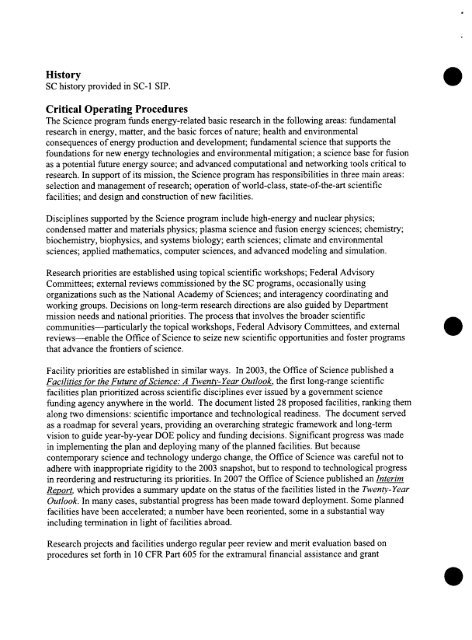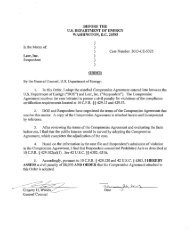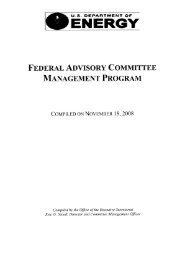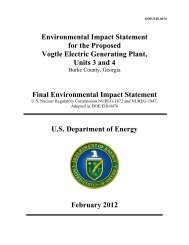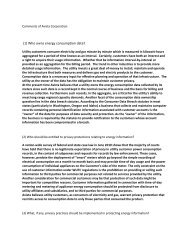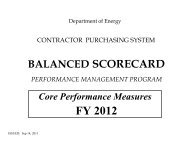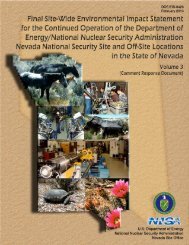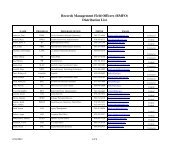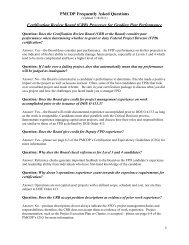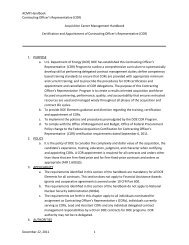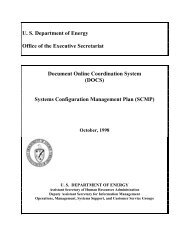- Page 1 and 2:
PROGRAM DETAILS BOOK THREE All 0
- Page 3 and 4:
Section 3 - Office of Energy Effici
- Page 5 and 6:
National Nuclear Security Adminstra
- Page 7 and 8:
Status Budget: NNSA Funding 10,000
- Page 9 and 10:
Performance: * Livermore Site Offic
- Page 11 and 12:
was established in Albuquerque, New
- Page 13 and 14:
Stockpile Stewardship The Stockpile
- Page 15 and 16:
and Nuclear Safety; the Office of t
- Page 17 and 18:
* Launch the Next Generation Safegu
- Page 19 and 20:
Funding Profile National Nuclear Se
- Page 21 and 22:
Organization Information Organizati
- Page 23 and 24:
* Complies with the DOE's "defense-
- Page 25 and 26:
Mission Statement In support of the
- Page 27 and 28:
minimum protection requirements bas
- Page 29 and 30:
Key Strategies and Timing Key strat
- Page 31 and 32:
Information Technology $60,o000o $5
- Page 33 and 34:
Organization Information National N
- Page 35 and 36:
NNSA works with other nations to de
- Page 37 and 38:
Current Organizational Chart NNSA C
- Page 39 and 40:
Strategic Theme 2, Nuclear Security
- Page 41 and 42:
The United States Nuclear Weapons C
- Page 43 and 44:
necessary research, development, an
- Page 45 and 46:
ensures that the SSP will meet the
- Page 47 and 48:
5. Provide safe, secure transportat
- Page 49 and 50:
policy questions regarding the Nati
- Page 51 and 52:
National Nuclear Security Administr
- Page 53 and 54:
Key Activities: DNN strives to achi
- Page 55 and 56:
History DNN was created when NNSA w
- Page 57 and 58:
* Reviewed over 7,000 export licens
- Page 59 and 60:
Funding Profile Defense Nuclear Non
- Page 61 and 62:
Organizational Information National
- Page 63 and 64:
Bettis Laboratory, Pittsburgh, PA (
- Page 65 and 66:
Presidential Executive Order 12344
- Page 67 and 68:
demolition (D&D) plan for the next
- Page 69 and 70:
* Propulsion plant development for
- Page 71 and 72:
Organization Information National N
- Page 73 and 74:
Facilities: Emergency Operations ma
- Page 75 and 76:
Hot Issues See Nuclear Incident Res
- Page 77 and 78:
National Nuclear Security Administr
- Page 79 and 80: NA-50 FY 2008 PART/Joule Performanc
- Page 81 and 82: Leadership Challenges Meeting the r
- Page 83 and 84: NA-50 Budget FY01-FYOS Appropriatio
- Page 85 and 86: Status Budget: Office of the Admini
- Page 87 and 88: Recent Organizational Accomplishmen
- Page 89 and 90: Current Organizational Chart Associ
- Page 91 and 92: Status Budget: Defense Nuclear Secu
- Page 93 and 94: * DNS conducted Performance Assuran
- Page 95 and 96: Employ risk management. Risk will b
- Page 97 and 98: NA-70 Budget FY01-FY08 Appropriatio
- Page 99 and 100: * Stockpile Stewardship and Weapons
- Page 101 and 102: * Climate Change. LLNL provides bot
- Page 103 and 104: S* LosAlamos NATIONAL LABORATORY --
- Page 105 and 106: * Los Alamos NATIONAL LABORATORY -
- Page 107 and 108: * LosAlamos NATIONAL LABORATORY - E
- Page 109 and 110: * Los Alamos NATIONAL LABORATORY S
- Page 111 and 112: f7;n Sandia I t National ri Laborar
- Page 113 and 114: Ss Sandia S Nationa l SLaboratories
- Page 115 and 116: at~ional laboratories * 2008 DOE Se
- Page 117 and 118: Status Budget: The Immediate Office
- Page 119 and 120: Organizational Structure Under Secr
- Page 121 and 122: The Relationship Between the Direct
- Page 123 and 124: Office of Science FY 2009 Budget Re
- Page 125 and 126: expansion, additional focus was giv
- Page 127 and 128: Following is a historical chart whi
- Page 129: Office of the Deputy Director for S
- Page 133 and 134: Current Organizational Chart a-f a
- Page 135 and 136: to contractual obligations at each
- Page 137 and 138: Hot Issues None noted. Competition
- Page 139 and 140: Office of the Deputy Director for R
- Page 141 and 142: Recent Organizational Accomplishmen
- Page 143 and 144: Organization Information Science Bu
- Page 145 and 146: Office of Science FY 2009 Budget Re
- Page 147 and 148: . Prepare and submit monthly Approv
- Page 149 and 150: provisions are intended to reduce A
- Page 151 and 152: Increased funding of 11.6% over the
- Page 153 and 154: Following is a historical chart whi
- Page 155 and 156: _\ AMES LABORATORY United States De
- Page 157 and 158: Argonne NATIONAL LABORATORY Major U
- Page 159 and 160: Major User Facilities * Relativisti
- Page 161 and 162: O Fermilab Major User Facilities *
- Page 163 and 164: Jefferson Lab IThomas Jefferson Nat
- Page 165 and 166: Srr Berkeley Lab Major User Facilit
- Page 167 and 168: R OAK RIDGE National Laborator. Maj
- Page 169 and 170: Pacific Northwest Major User Facili
- Page 171 and 172: PtinrETOI PLRUSIA PfYSILS L33ORIFlT
- Page 173 and 174: O1f I A Major User Facilities * Lin
- Page 175 and 176: Organization Information Hydrogen T
- Page 177 and 178: Technology Program utilizes the res
- Page 179 and 180: Transportation (DOT) through an int
- Page 181 and 182:
Funding Profile Dollars in thousand
- Page 183 and 184:
Organization Information Vehicle Te
- Page 185 and 186:
History The earliest progenitor of
- Page 187 and 188:
Key Strategies and Timing S14.0%---
- Page 189 and 190:
Funding Profile Dollars in thousand
- Page 191 and 192:
Organization Information Solar Ener
- Page 193 and 194:
History Solar energy technologies h
- Page 195 and 196:
Key Strategies and Timing PV (Resid
- Page 197 and 198:
400 Program Funding (Actual Dollars
- Page 199 and 200:
Organization Information Organizati
- Page 201 and 202:
The program continued applied resea
- Page 203 and 204:
* World class expertise and researc
- Page 205 and 206:
Future technology R&D activities in
- Page 207 and 208:
Production Tax Credit (PTC) - The P
- Page 209 and 210:
Current Organizational Chart Wind E
- Page 211 and 212:
Status Budget: Water Power Program
- Page 213 and 214:
federal staffing levels. Current fe
- Page 215 and 216:
Current Organizational Chart Water
- Page 217 and 218:
Status Budget: Geothermal Technolog
- Page 219 and 220:
DOE has: * Re-organized the program
- Page 221 and 222:
Current Organizational Chart Geothe
- Page 223 and 224:
* Increase the supply of renewable
- Page 225 and 226:
Recent Organizational Accomplishmen
- Page 227 and 228:
* Demonstration projects are being
- Page 229 and 230:
Hot Issues * Ground Breaking for th
- Page 231 and 232:
Current Organizational Chart Biomas
- Page 233 and 234:
Status Budget: Federal Energy Manag
- Page 235 and 236:
* Coordinates the planning, data co
- Page 237 and 238:
12-month events *Annual Report to C
- Page 239 and 240:
Current Organizational Chart Federa
- Page 241 and 242:
* High-growth industries such as co
- Page 243 and 244:
Organizational Accomplishments Thro
- Page 245 and 246:
Hot Issues September 2009 * Initiat
- Page 247 and 248:
Current Organizational Chart Indust
- Page 249 and 250:
Status Budget: 140 - 120 100 80 . .
- Page 251 and 252:
Recent Organizational Accomplishmen
- Page 253 and 254:
with greatly reduced needs for ener
- Page 255 and 256:
Funding Profile Dollars in thousand
- Page 257 and 258:
Weatherization and Intergovernmenta
- Page 259 and 260:
WIP was established in 2003, combin
- Page 261 and 262:
Organizational Strengths . Specific
- Page 263 and 264:
Funding Profile Dollars in thousand
- Page 265 and 266:
Organization Information EERE Progr
- Page 267 and 268:
Status Budget: 25 20 t 15 10 5 Prog
- Page 269 and 270:
implied mortgages for program plann
- Page 271 and 272:
Hot Issues The issues presented her
- Page 273 and 274:
Current Organizational Chart Planni
- Page 275 and 276:
National Renewable Energy Lab SMiss
- Page 277 and 278:
National Renewable Energy Lab * The
- Page 279 and 280:
National Renewable Energy Lab Recen
- Page 281 and 282:
* Clean Coal Program Organization I
- Page 283 and 284:
Clean Coal - R&D Program 400 383 S3
- Page 285 and 286:
History carbon capture, transport,
- Page 287 and 288:
multilateral agreements, including
- Page 289 and 290:
B depleted oil field. * Testing beg
- Page 291 and 292:
program targets technology to gener
- Page 293 and 294:
* Methane Hydrate Program Organizat
- Page 295 and 296:
Government role in methane hydrate
- Page 297 and 298:
hydrate resource in a dozen basins
- Page 299 and 300:
Supporting Education and Training S
- Page 301 and 302:
Strategy: Leverage International Co
- Page 303 and 304:
p Ultra-Deepwater and Unconventiona
- Page 305 and 306:
History SToday, oil and natural gas
- Page 307 and 308:
commonly used Ni-base alloys and au
- Page 309 and 310:
Organization Information Organizati
- Page 311 and 312:
FY2009 Congressional Request: SPR $
- Page 313 and 314:
On May 19, 2008, Congress passed th
- Page 315 and 316:
NPOSR: The NPR-3 and RMOTC faciliti
- Page 317 and 318:
ISPR Inventory SPR Import Protectio
- Page 319 and 320:
Congress enacted legislation to sus
- Page 321 and 322:
Current Organizational Chart Office
- Page 323 and 324:
TL NNATIONAL ENERGY TECHNOLOGY LABO
- Page 325 and 326:
N TL NATIONAL ENERGY TECHNOLOGY LAB
- Page 327 and 328:
N gTL NATIONAL ENERGY TECHNOLOGY LA
- Page 329 and 330:
Organization Information Address: 1
- Page 331 and 332:
Nuclear Power Deployment The Office
- Page 333 and 334:
Nuclear Power 2010 Organization Inf
- Page 335 and 336:
power plants in the 2010 timeframe
- Page 337 and 338:
application preparation guidance fo
- Page 339 and 340:
Organization Information Idaho Nucl
- Page 341 and 342:
History services to other national
- Page 343 and 344:
* Apply its technical skills to enh
- Page 345 and 346:
S revisions to control and accounta
- Page 347 and 348:
Status Budget: Generation IV Nuclea
- Page 349 and 350:
esearch, design, and demonstration
- Page 351 and 352:
Organization Information Organizati
- Page 353 and 354:
Critical Operating Procedures NHI w
- Page 355 and 356:
Hot Issues None Current Organizatio
- Page 357 and 358:
Mission Statement Develop, produce,
- Page 359 and 360:
Recent Organizational Accomplishmen
- Page 361 and 362:
Begin to update safety knowledge ba
- Page 363 and 364:
Status Budget: 400 320 I 240167 Adv
- Page 365 and 366:
In parallel with these internationa
- Page 367 and 368:
International Nuclear Energy Policy
- Page 369 and 370:
The U.S.-Russia Bilateral Action Pl
- Page 371 and 372:
management. NE takes an active role
- Page 373 and 374:
Hot Issues DOE has strongly support
- Page 375 and 376:
History People: Number of federal F
- Page 377 and 378:
Idaho National Laboratory Mission I
- Page 379 and 380:
MNL separations and processing, sen
- Page 381 and 382:
WNL * Developed plug and play techn
- Page 383 and 384:
Office of Electricity Delivery and
- Page 385 and 386:
proposes National Interest Electric
- Page 387 and 388:
operational responsibility to monit
- Page 389 and 390:
S Critical Events and Action Items
- Page 391 and 392:
Office of Electricity Delivery and
- Page 393 and 394:
Organization Information Office of
- Page 395 and 396:
Figure 1. Sites/Facilities Closures
- Page 397 and 398:
provided EM with insight into criti
- Page 399 and 400:
EM is focusing its activities on id
- Page 401 and 402:
without re-prioritizing existing cl
- Page 403 and 404:
* SRNL ..\ ^ SAVANNAH P, IVEllATImO
- Page 405 and 406:
* SRNL >S IVANNA IUVEINAIONAL LA3OD
- Page 407 and 408:
ntt SRNL SAVAMMOAH RVER NMIONAL IMT
- Page 409 and 410:
n SRNL S^ ^ SAVANMAH IVEI NATIONAL
- Page 411 and 412:
Office of Civilian Radioactive Wast
- Page 413 and 414:
Performance measures: PART rating:
- Page 415 and 416:
to the NRC and copies of these docu
- Page 417 and 418:
Taxpayer Liability In 1997, the U.
- Page 419 and 420:
OCRWM Program Budget History 700 60
- Page 421 and 422:
January 4, 2009 Organization Chart
- Page 423 and 424:
Organization Information Organizati
- Page 425 and 426:
Status Budget: Legacy Management Fu
- Page 427 and 428:
Request, and the Department will ta
- Page 429 and 430:
* DOE Information technology requir
- Page 431 and 432:
* LM will only accept responsibilit
- Page 433 and 434:
7/28/OS Office of Legacy Management
- Page 435 and 436:
Organization Information Western Ar
- Page 437 and 438:
We set power rates to recover all c
- Page 439 and 440:
SERVICE AREAS SIERRA NEVADA REGION
- Page 441 and 442:
increases in available Federal reso
- Page 443 and 444:
These are areas where existing cong
- Page 445 and 446:
Strategy 4.2: Human capital Attract
- Page 447 and 448:
Technology Upgrade (MRTU) project.
- Page 449 and 450:
Organizational Chart Timothy J. Mee
- Page 451 and 452:
* A transmission system that is ade
- Page 453 and 454:
* Stakeholder Perspective o The val
- Page 455 and 456:
Completion of Network Open Season:
- Page 457 and 458:
Stakeholder Satisfaction: BPA will
- Page 459 and 460:
moment based on changes in wind spe
- Page 461 and 462:
Organization Information Southeaste
- Page 463 and 464:
Purchase Power and Wheeling: The Pu
- Page 465 and 466:
Southeastern's hydroelectric genera
- Page 467 and 468:
egional reliability initiatives, So
- Page 469 and 470:
(3) The FY 2010 Energy & Water Deve
- Page 471 and 472:
Southwestern Power Administration O
- Page 473 and 474:
History Southwestern was establishe
- Page 475 and 476:
Southwestern CPS 1 Measurements Sou
- Page 477 and 478:
12-month events January thru Decemb
- Page 479 and 480:
Current Organizational Chart (CEOI
- Page 481 and 482:
SEnergy Information Administration
- Page 483 and 484:
FY 2 0 0 7 4 th quarter Joule statu
- Page 485 and 486:
Office ofEnergy Markets and End Use
- Page 487 and 488:
* Identify and regularly update rel
- Page 489 and 490:
Winter Heating Season In its recent
- Page 491 and 492:
Current Organizational Chart Admini
- Page 493 and 494:
Organization Information Organizati
- Page 495 and 496:
eorganization associated with the C
- Page 497 and 498:
The Department of Energy financial
- Page 499 and 500:
Leadership Challenges CFO managemen
- Page 501 and 502:
Funding Profile The following table
- Page 503 and 504:
Organization Information Office of
- Page 505 and 506:
Status In order to accomplish its m
- Page 507 and 508:
CRITICAL OPERATING PROCEDURES The O
- Page 509 and 510:
Information Technology Council In o
- Page 511 and 512:
On July 15, 2008, the OCIO hosted C
- Page 513 and 514:
12-Month Events May 2009 CYBER SECU
- Page 515 and 516:
Organizational Information: Congres
- Page 517 and 518:
1997 - The Office of Congressional,
- Page 519 and 520:
on the potential impacts of energy
- Page 521 and 522:
(4) Develop initial set of legislat
- Page 523 and 524:
CI-20, 30, 40 - Deputy Assistant Se
- Page 525 and 526:
Status Budget: The FY 2009 proposed
- Page 527 and 528:
manner. This system assists in prep
- Page 529 and 530:
Proposed Organizational Chart Offic
- Page 531 and 532:
Status Budget: General Counsel 40 3
- Page 533 and 534:
Deputy General Counselfor Environme
- Page 535 and 536:
Office ofNEPA Policy and Compliance
- Page 537 and 538:
Critical Operating Procedures GC is
- Page 539 and 540:
Organization Information Office of
- Page 541 and 542:
Enforcement - HSS promotes vigilanc
- Page 543 and 544:
Critical Operating Procedures HSS c
- Page 545 and 546:
* Former Worker Program - HSS publi
- Page 547 and 548:
Leadership Challenges Although the
- Page 549 and 550:
Critical Events and Action Items Ho
- Page 551 and 552:
Expanded Organizational Chart Offic
- Page 553 and 554:
Status Budget: FY '09 Congressional
- Page 555 and 556:
1973-1981 price controls on the sal
- Page 557 and 558:
Current organizational chart with i
- Page 559 and 560:
Vision Statement Work through colla
- Page 561 and 562:
Critical Operating Procedures HC is
- Page 563 and 564:
launched a pilot with 64 students f
- Page 565 and 566:
April 2009 Continue Secretary's Awa
- Page 567 and 568:
Current Organizational Chart OFFICE
- Page 569 and 570:
The Office is in the third year of
- Page 571 and 572:
Origins ofDOE's Intelligence Progra
- Page 573 and 574:
o o o o o o Created and vetted a co
- Page 575 and 576:
o o Assume increased program manage
- Page 577 and 578:
Organization Information Organizati
- Page 579 and 580:
Efficiency Measure: Conduct reviews
- Page 581 and 582:
Representing risks inherent to the
- Page 583 and 584:
Organization Information Organizati
- Page 585 and 586:
een in existence since the Departme
- Page 587 and 588:
Office of Procurement and Assistanc
- Page 589 and 590:
o o o o o Princeton Plasma Physics
- Page 591 and 592:
* Install a pressurization system w
- Page 593 and 594:
Current Organization Office of Mana
- Page 595 and 596:
Status Budget: FY2009 Congressional
- Page 597 and 598:
-PI has performed extensive modelin
- Page 599 and 600:
transparent energy and C02 pollutio
- Page 601 and 602:
Organization Information Organizati
- Page 603 and 604:
1997 - The Office of Congressional,
- Page 605 and 606:
Public Information Activities * Res
- Page 607:
Andrew Beck Director Eyeliner Jones


